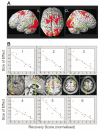Neural correlates of motor recovery after stroke: a longitudinal fMRI study
- PMID: 12937084
- PMCID: PMC3717457
- DOI: 10.1093/brain/awg245
Neural correlates of motor recovery after stroke: a longitudinal fMRI study
Abstract
Recovery of motor function after stroke may occur over weeks or months and is often attributed to cerebral reorganization. We have investigated the longitudinal relationship between recovery after stroke and task-related brain activation during a motor task as measured using functional MRI (fMRI). Eight first-ever stroke patients presenting with hemiparesis resulting from cerebral infarction sparing the primary motor cortex, and four control subjects were recruited. Subjects were scanned on a number of occasions whilst performing an isometric dynamic visually paced hand grip task. Recovery in the patient group was assessed using a battery of outcome measures at each time point. Task-related brain activations decreased over sessions as a function of recovery in a number of primary and non-primary motor regions in all patients, but no session effects were seen in the controls. Furthermore, consistent decreases across sessions correlating with recovery were seen across the whole patient group independent of rate of recovery or initial severity, in primary motor cortex, premotor and prefrontal cortex, supplementary motor areas, cingulate sulcus, temporal lobe, striate cortex, cerebellum, thalamus and basal ganglia. Although recovery-related increases were seen in different brain regions in four patients, there were no consistent effects across the group. These results further our understanding of the recovery process by demonstrating for the first time a clear temporal relationship between recovery and task-related activation of the motor system after stroke.
Figures




References
-
- Andersson JL, Hutton C, Ashburner J, Turner R, Friston K. Modeling geometric deformations in EPI time series. Neuroimage. 2001;13:903–19. - PubMed
-
- Binkofski F, Fink GR, Geyer S, Buccino G, Gruber O, Shah NJ, et al. Neural activity in human primary motor cortex areas 4a and 4p is modulated differentially by attention to action. J Neurophysiol. 2002;88:514–9. - PubMed
-
- Blakemore SJ, Frith CD, Wolpert DM. The cerebellum is involved in predicting the sensory consequences of action. Neuroreport. 2001;12:1879–84. - PubMed
-
- Brett M, Leff AP, Rorden C, Ashburner J. Spatial normalization of brain images with focal lesions using cost function masking. Neuroimage. 2001;14:486–500. - PubMed
-
- Buchkremer-Ratzmann I, August M, Hagemann G, Witte OW. Electrophysiological transcortical diaschisis after cortical photothrombosis in rat brain. Stroke. 1996;27:1105–9. - PubMed
Publication types
MeSH terms
Grants and funding
LinkOut - more resources
Full Text Sources
Other Literature Sources

